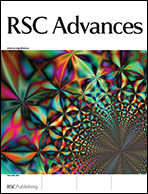The cooperative utilization of imprinting, electro-spinning and a pore-forming agent to synthesise β-cyclodextrin polymers with enhanced recognition of naringin
Abstract
The aim of this study was to identify if the addition of an inorganic pore-forming agent (PFA) could provide an efficient route to significantly improve the binding capacity of molecularly imprinted nanofibers (MINs), along with increasing their imprinting effect and selectivity. A non-covalently imprinted composite nanofiber (MIN–PFA) with in situ generated silica as a pore-forming agent was prepared using an electro-spinning technique with naringin (NG) as a template, β-cyclodextrin as a functional monomer, hexamethylene diisocyanate as a cross-linker, and polyvinyl butyral as an electro-spinning matrix. For comparison purposes, two imprinted polymers (MIN and MIP) were prepared in the absence of PFA, with or without electro-spinning employed. The binding properties and selectivity of the nanofibers were evaluated using equilibrium binding experiments. MIN–PFA exhibited a high specific binding capacity (∼13.0 μmol g−1) towards naringin, binding 30% and 57% more than MIN and MIP, respectively. The N2 gas adsorption isotherm at 77 K also demonstrated that the addition of PFA could enhance the surface area of the imprinted nanofibers.


 Please wait while we load your content...
Please wait while we load your content...